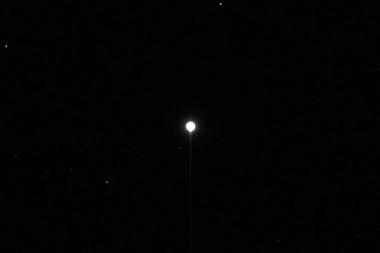
A NASA spacecraft has captured new video of the huge asteroid Vesta ahead of a planned rendezvous with the space rock in July, revealing an odd, dark spot that has astronomers buzzing.
NASA's Dawn probe will arrive in orbit around Vesta, the second-largest asteroid in the solar system, on July 16. The spacecraft has been taking photos of Vesta with its framing camera since May to help prepare for the close encounter.
The new video is actually a series of 20 photographs taken during a 30-minute period on June 1, when Dawn was about 300,000 miles (483,000 kilometers) from the giant space rock. The images, which capture about 10 percent of a full rotation, reveal several intriguing features on the 330-mile-wide (530-km) Vesta. [Watch the new asteroid Vesta video]
For example, the video shows a dark blotch about 60 miles (97 km) wide near Vesta's equator, moving from left to right across the field of view as Vesta rotates.
"Like strangers in a strange land, we're looking for familiar landmarks," said Jian-Yang Li, a Dawn scientist from the University of Maryland, in a statement. "The shadowy spot is one of those - it appears to match a feature, known as 'Feature B,' from images of Vesta taken by NASA's Hubble Space Telescope."
Vesta Video Session
The images also show Vesta's jagged, irregular shape, hinting at the enormous crater known to exist at Vesta's south pole. The resolution of the photos approaches that of the best Hubble pictures of Vesta, researchers said.
Before orbiting Vesta on July 16, Dawn will gently slow down to about 75 mph (120 kph). NASA should release more images on a weekly basis, with photos available more frequently once the spacecraft begins collecting science at Vesta, agency officials said.
"Vesta is coming more and more into focus," said Andreas Nathues, framing camera lead investigator, based at the Max Planck Institute for Solar System Research in Germany. "Dawn's framing camera is working exactly as anticipated."
Next Stop: Asteroid Belt
Vesta is located in the asteroid belt, which lies between the orbits of Mars and Jupiter. Dawn will orbit and study Vesta for a year, then move on to investigate the belt's largest body, the dwarf planet Ceres. The spacecraft will arrive at this behemoth in 2015.
Scientists hope Dawn will help unlock secrets of our solar system's early history by studying these two icons of the asteroid belt. Dawn's mission will be to compare and contrast the two giant bodies, which were shaped by different forces.
The spacecraft's science instruments will measure surface composition, topography and texture. Dawn will also measure the tug of gravity from Vesta and Ceres to learn more about their internal structures.
By the end of its mission, Dawn will have traveled 3 billion miles (5 billion km) since its launch in September 2007.



Reader Comments
to our Newsletter